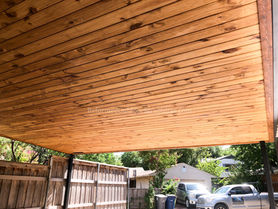Overhead Structures
Traditional Patio Covers
Traditional patio covers are classic outdoor structures designed to provide shade and protection from the elements while complementing the architectural style of the home. Typically constructed from wood or vinyl, they often feature decorative elements like columns, latticework, or gabled roofs that evoke timeless charm. These covers may be attached to the house or freestanding, and are commonly built with fixed roofs or open-beam designs that support climbing plants or hanging lights. While they prioritize function and comfort, traditional patio covers also emphasize craftsmanship and ornamental detail, creating cozy, inviting spaces for relaxation and gatherings. There are many ways to "Finish Out" your custom patio cover. You may prefer a tongue and groove flat ceiling to give your patio cover a modern look, while others prefer the more rustic look with visible cedar rafters. Our knee braces can have a design cut. We have a variety of stain colors to choose from. All of this is amendable to fit your most particular intentions.
Modern Patio Covers
Modern patio covers are sleek, functional structures designed to enhance outdoor living by providing shade, shelter, and style. They feature minimalist designs with clean lines and are built from durable materials like aluminum, steel, treated wood, or polycarbonate panels. Often customizable, these covers may include smart features such as motorized louvers, integrated lighting, or retractable canopies, allowing homeowners to control sunlight and airflow. Whether freestanding or attached to the home, modern patio covers blend seamlessly with contemporary architecture, transforming patios into comfortable, year-round extensions of indoor space.
Pergolas
An outdoor pergola is a nice addition for your garden, patio or outdoor area. Apart from providing some shade or cover, it also has a decorative purpose. Pergolas can be built in various shapes and sizes. This will depend on the main purpose for building it and it will also directly affect the types of material used. USING CEDAR FOR YOUR PERGOLA? A pergola can be made to be freestanding or as part of a wall or roof. Wood can accommodate both such designs. Cedar is one of the most commonly used materials for such a project. The natural look of the wood is often sought after in such a case although some people may prefer to paint it as well. Cedar contains natural oils which makes it more resistant to rot, decay, termites, fungi and insects as well as warping and shrinking. In any case the cedar will then be sealed or stained to provide some extra protection against the adverse weather conditions that it will be exposed to, mostly moisture from rain and dew. It will also reduce the emergence of problems such as chipping and cracking. USING METAL? Building a pergola from metal may not be very popular in the eyes of some people who prefer to have a natural, rustic look. However, others may prefer to go for resistance rather than looks, and in such a case building a pergola from metal is the right option. Needless to be said metal is highly resistant and robust. If the pergola is going to be rather large it may be the most resistant option. The main deterrent of metal is obviously rust; hence appropriate action should be take to protect the metal by galvanizing it and regularly maintaining it with suitable sealers which will prevent rust from emerging. Scrolled metal or metal tubing are usually utilized by welding and bolting them together. USING PVC? PVC is also a very good option for building a pergola. Using PVC will provide a resistant material and prevent the problems that metal and wood can cause due to outdoor conditions. It also has the advantage of not requiring much maintenance, if any at all.
Pavilions
Pavilions provide a shaded and protected outdoor space ideal for hosting events, socializing, dining, or relaxation under a canopy. This makes them popular for backyards, parks, sports grounds, and public venues. They serve many roles including garden retreats, bandstands, exhibition venues, and gathering spots. Pavilions exist in many shapes such as square, rectangular, circular (often called gazebos), octagonal, or custom forms. Roof styles may range from simple flat or pitched designs to elaborate pagoda-like tiered roofs.
Arbors
An arbor is typically a vertical structure in gardens or landscapes featuring two to four posts holding up a slatted roof, which may be arched or flat. The sides often include open lattice or trellis work that allows climbing plants such as roses, clematis, or wisteria to grow and cover the structure. This creates a living canopy that provides shade, privacy, and beauty. Arbors form a focal point, frame walkways, define garden rooms, or mark garden entrances, often placed over paths, gates, or seating areas to enhance garden appeal and provide restful spots.
Cabanas
The term "cabana" originates from the Spanish word cabaña, meaning hut or cabin. Traditionally, cabanas were simple huts used for changing clothes or shelter on beaches. Today, cabanas have evolved into elegant and functional structures that enhance outdoor pool spaces with privacy and shade. They generally have a roof and at least one partially enclosed side, differentiating them from open structures like gazebos or pergolas.
Carports
A carport is a practical, affordable, and versatile solution for protecting vehicles from weather damage when a garage is not available or necessary. It combines shelter with ease of access and enhanced airflow, available in multiple styles and materials to suit varying needs and budgets. Whether freestanding or attached, metal or wood, carports are a popular choice for homeowners seeking functional outdoor vehicle protection.
Trellises
By elevating plants off the ground, trellises improve sunlight exposure, promote healthier plants by improving airflow, reduce fungal disease, and deter pests. They also facilitate vertical gardening in small spaces, increase plant yields, and can serve as privacy screens or garden dividers, contributing to an organized and inviting outdoor environment.















































